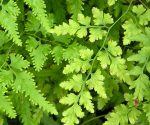
Japanese climbing fern is a perennial deciduous vine-type of fern and is one of 40 species of climbing ferns. It is native to eastern and southeastern Asia, India, and eastern Australia but was introduced into Georgia by 1903 and is now considered invasive in much of southeastern US where it grows in moist woods, swamps and riparian habitats, and smothers native vegetation. The plant has slender, black,wiry rhizomes that give rise to thin tough twining stem-like structures that can grow up to 98’ long. The leaves/fronds that grow from the stems are actually leaflets and are lobed or dissected and have curved hairs on their underside. Some are infertile while others are fertile and carry double rows of sporangia under the margins of their finger like projections. The vine has been cultivated in Florida as an ornamental but its invasive tendencies warn against such a practice. The genus name, Lygodium, comes from the Greek word for flexible. The specific epithet, japonicum, refers to the geographic distribution of the plant.
Type: Perennial deciduous vine
Bloom: Not applicable
Size: Up to 98’ long
Light: Shade to full sun
Soil: Average, moist to wet
Hardiness: Zones 8-10
Care: Cut back to control invasiveness
Pests and Diseases: None of significance
Propagation: Spores
Companion Plants: Avoid growing with other plants as it will likely cover and smother them.